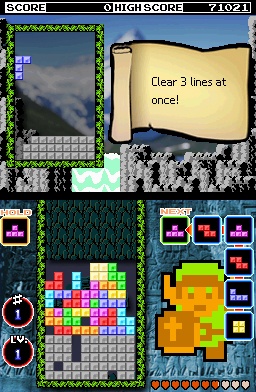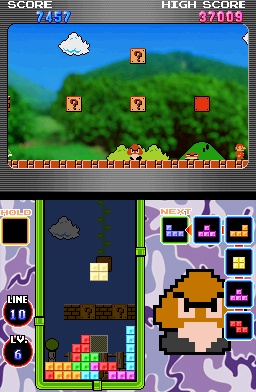There is a distinct chance that, were it not for Tetris, there would not be a Nintendo DS. Though there were superior versions of Alexei Pajitnov's elegant and dangerously addictive puzzle game available on other platforms, Tetris for the original Game Boy was the reason to buy Nintendo's first handheld. Considering the significance of Tetris to Nintendo's handheld legacy, it's a little surprising that it took this long for it to show up on the DS. Tetris DS features a great variety of gameplay variants and online play, and is absolutely smothered in 8-bit Nintendo nostalgia; yet the package makes enough minor, obvious mistakes to keep it from being absolutely essential.

We're just going to assume here that you've played Tetris before--however, for those who haven't played Tetris since it was rendered in green-and-grey on the Game Boy, some changes have been made to the formula. Top of the list is the introduction of the hold box, which lets you take the active piece in play and put it to the side for later use; it can be a lifesaver when you have a piece that won't fit snugly into your playfield, or when you're setting yourself up for a four-line Tetris. Another less obvious and more damaging change is the infinite spin. This was a "feature" we first discovered in THQ's Tetris Worlds, where, even when a piece had touched down, you could keep it in play by constantly rotating it. It's a genuinely awful thing, though the infinite spin issue honestly really affects only a few of the single-player gameplay modes in Tetris DS, because any competitive mode requires you to lay down pieces as quickly as humanly possible. It's still incredibly bothersome that this quirk seems to be on its way to becoming Tetris canon.
There's also the hard drop, which will instantly place the piece in play at the bottom of the playfield when you tap up on the D pad, as well as the ghost piece, which shows a translucent projection of the piece in play on the bottom of the playfield. Both of these are pretty minor and can actually be turned off, though oddly, the hold box and the infinite spin cannot. The general lack of customization is rather glaring throughout Tetris DS. Sure, there's a number of unique gameplay modes here, but by simply including the option to let the player tweak some of the settings, that number could have increased exponentially.
What's even more immediately striking than these fundamental gameplay tweaks is the presentation of Tetris DS, as Nintendo has plastered the game with all kinds of classic 8-bit Nintendo sights and sounds. It covers the basics with themes based on Super Mario Bros., The Legend of Zelda, Donkey Kong, and Metroid, though it also includes themes based on less well-known properties like Excitebike, Balloon Fight, and Yoshi's Cookie. Ultimately, the biggest problem with the presentation is that it banks too much on nostalgia, and frankly, we don't always want to listen to the Super Mario Bros. music on loop while we play Tetris. A lot of the themes are inexorably linked to specific gameplay modes, which means that if you don't much care for a certain piece of music, you're going to want to stay away from certain modes.
The single-player game is divvied up into six different styles of play, many of which contain several distinct modes. Standard Tetris is about as close to vanilla Tetris as you'll find in Tetris DS, and the modes contained within it are, well, pretty standard. Marathon challenges you to clear 200 lines, line clear lets you set the drop speed and the number of uncleared lines you start with, and VS CPU puts you up against some artificial intelligence that quickly goes from grade school to diabolical Tetris mastermind. Push, which can be played against the CPU or a live opponent, puts an interesting spin on standard two-player Tetris by having both players share the same baseline. Clearing lines pushes the baseline closer to the top of your opponent's field (which, from your perspective, looks like the bottom of your own field) until one of you runs out of room.
The touch style will have you pulling out your stylus and using it to slide around and rotate pieces that are already on the playfield in order to clear lines. Touch features two modes. Tower presents you with a massive pile of jumbled-up pieces that you'll have to clear in order to bring precious freedom to a cage of balloons--yup, balloons--while touch puzzle gives you a relatively limited number of pieces to work with, but challenges you to completely clear out the entire playfield, and without the ability to rotate pieces. While identifiable as Tetris only because of the familiarity of the piece shapes, both of the touch modes can be fun, though the touch puzzle mode provides an especially satisfying, and occasionally maddening, challenge. There's also a non-touch puzzle mode, in which you're presented with a field with a number of lines already on it, and then given a few specific pieces to use in order to completely clear the field. There are 200 unique puzzles, which slowly but surely increase in complexity, and they can be just as crazymaking as the touch puzzles.
The mission style, which can be played in a marathon or time trial mode, starts off like a regular game of Tetris, though simply clearing lines isn't enough to advance you. While your playfield resides on the lower screen, the top screen presents you with specific tasks that you must complete in order to advance. Sometimes you'll need to clear a number of lines with a single, specific piece, sometimes you'll need to clear one line without rotating any pieces--whatever the challenge, if you don't do it in a timely manner, the game will punish you by adding lines to the bottom of the field. Though superb for sharpening your Tetris chops, it can also be confusing, as some of the task descriptions aren't completely concise, and some of the tasks themselves can just be totally frustrating to actually pull off.
Lastly, there's catch, which only barely resembles Tetris--though, unlike the touch games, catch just isn't much fun. You're given a four-block core that you can move and rotate at will on the lower screen, while pieces slowly descend from the top screen. When they reach the lower screen, you can attach them to your core just by letting them touch down. The goal here is to create solid four-by-four sets of blocks, which when created will explode, simultaneously advancing your score and bringing the size of your cluster back down to a manageable one. Things get complicated as more pieces start to fall along with block-destroying obstacles, but the pacing never really speeds up adequately, and the whole thing just starts to feel like a grind.
A few of the modes mentioned have multiplayer components as well, and you can play standard, mission, and push games against other players locally--best of all, the other players don't even need to have copies of the game. Tetris DS features some of the best game sharing we've seen on the Nintendo DS, allowing up to 10 people to participate in massive, competitive games of Tetris. The local multiplayer is also one of the few places in Tetris DS where you can actually make modifications to the rules, most notably the ability to form between two teams of five and five teams of two, and the ability to turn on or off items. The items, which can have positive and negative effects ranging from giving you nothing but straight pieces for a limited time to preventing an opponent from rotating their pieces, can be picked up by clearing lines that contains special flashing blocks, and can be stored until you activate them with the X button.

The local multiplayer is hands down the best thing going for Tetris DS, which should say a lot about the quality of the game's online multiplayer. Yes, Tetris DS is online-enabled, though it's kind of underwhelming, since there are only three different modes, none of which you can modify. There's standard two-player, two-player push, and standard four-player with items. You want to play a two-player game, but with items? Or maybe you want to play a three-player game? With Tetris DS, you're out of luck. For what it's worth, the online experience worked well enough, but by comparison to the local multiplayer offered, it just seems poorly realized.
Tetris DS has a lot going for it--plenty of gameplay modes, amazing game sharing, and online play--which makes it all the more disappointing that it contains no "pure" Tetris experience, and features a weak selection of online gameplay modes. But still, it's Tetris, one of the most popular and significant puzzle games ever, and some of the magic that put it in such a venerable position still manages to shine through.